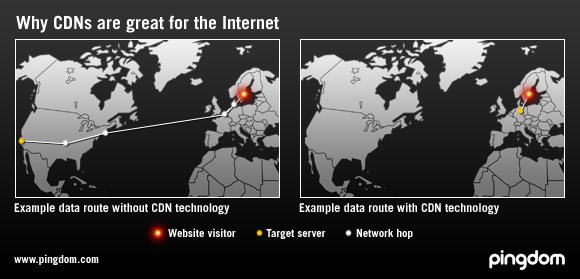CDNs (Content Delivery Networks) are becoming increasingly popular. The obvious benefit is that they can help websites to give end users a speedier web surfing experience, but there is also another very positive side effect for the entire Internet, and it will become more noticeable the more common CDNs become.
The positive side effect is this: More CDN usage means less load on the Internet backbone.
Why? It all comes down to how most CDNs work.
Accessing a website that has no CDN
A regular website, with no CDN, serves all of its content from one static location, no matter where the website visitor is coming from. So, for example, if a European web surfer is visiting a website hosted in the United States, all the website content will be transferred from the American web hosting company across the Atlantic to the European user, via multiple network hops in both the United States and Europe.
Now contrast this with a good CDN, which will have multiple locations spread out over the world. It will make sure that content is always served from the location that is closest to the web surfer.
Accessing a website that has a CDN
When for example the European web surfer we mentioned above accesses the same site, which now uses a CDN, he will download the website content from a location in Europe, perhaps even in his own country. The data will only have to travel a fraction of the distance, with fewer network hops.
In other words: A much smaller part of the Internet infrastructure will have to be involved in the user’s interaction with this specific website.

Above: This is a visualization of the example mentioned in this article. Note that a much smaller part of the network infrastructure is used when the CDN is involved.
There may still be some data that needs to be transferred over the entire distance. Many sites only use CDNs for static files (for example images), but it will still greatly ease the load on the Internet backbone.
We suspect that 10 years from now, most web hosting solutions will have some form of built-in CDN, and this will be a Good Thing for the Internet.
What do you think?
Further reading: If you’re interested in some additional insights about CDNs, you might like to check out an article from 2008: A look at Content Delivery Networks, or “how to serve lots of content really fast”



























